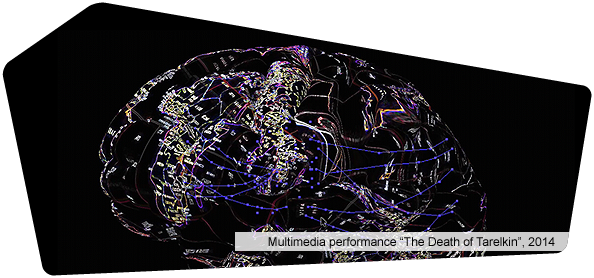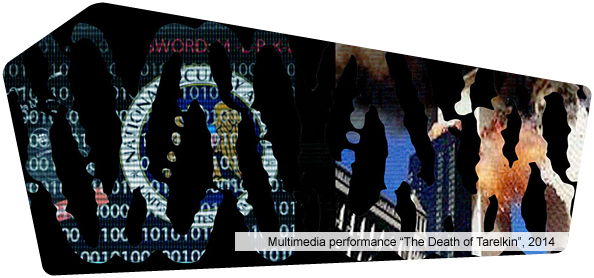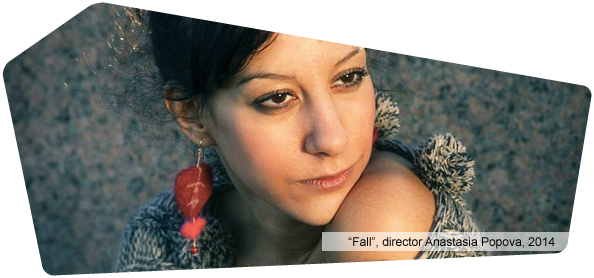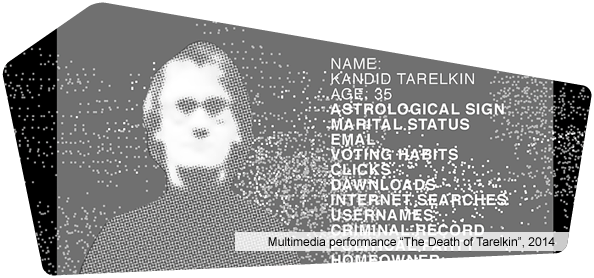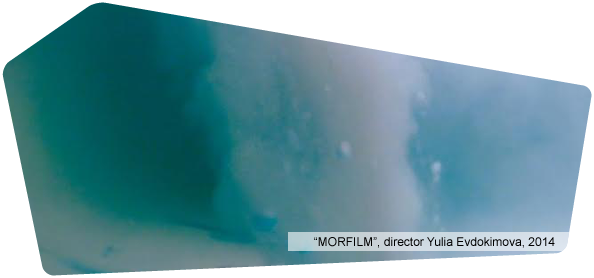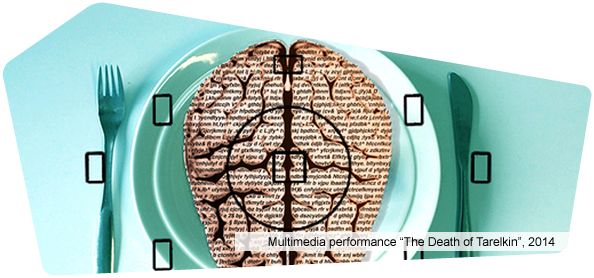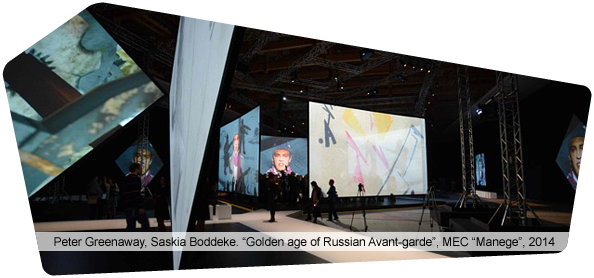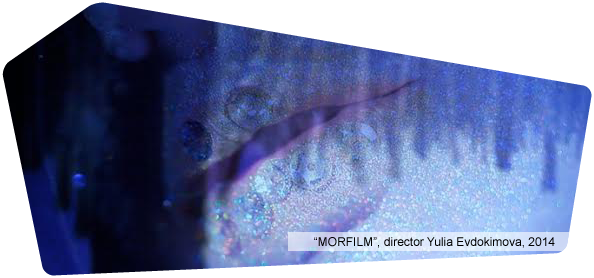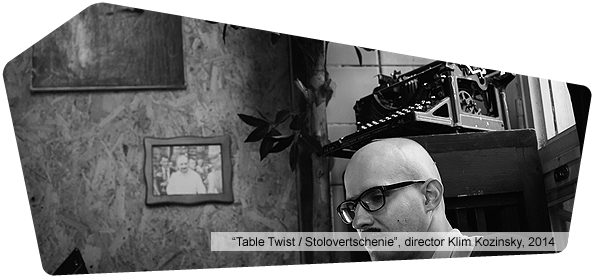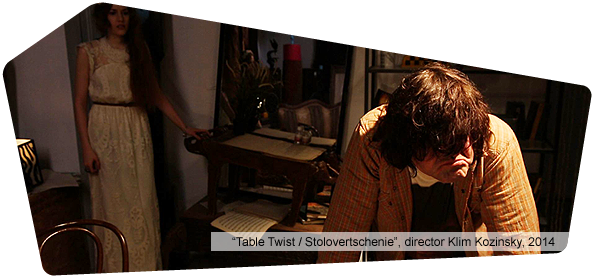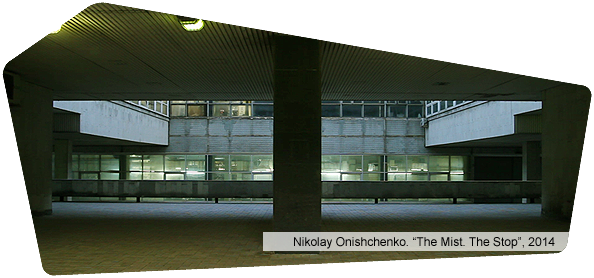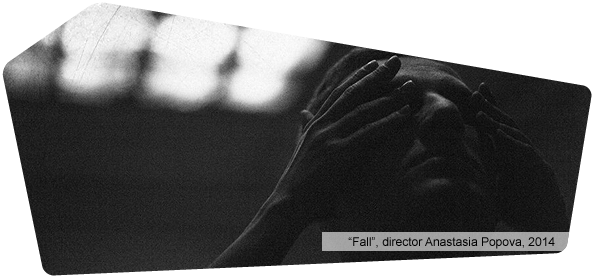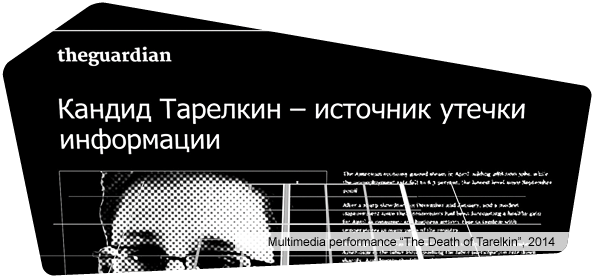About Media Forum

Schedule

Conference “From Montage of Attractions to Neurocinema”

Nikolay Onishchenko. Exhibition “Mist. Halt”

Kino-harakiri Interactive Show

Multimedia performance “The Death of Tarelkin”

For Press

Partners

Contacts
XV Media Forum of 36 Moscow International Film Festival, June 23—27, 2014
Organized by: MediaFest, MediaArtLab Centre for Art and Culture, Mediafest, Museum Exhibition Complex "Manege"
Partners: Moscow Museum, International Centre for Dance and Performance TsEKh, Theatre “Balet Moskva”/ Ballet Moscow, Triumph Gallery
![]() XV Media Forum of the 36 MIFF (.pdf)
XV Media Forum of the 36 MIFF (.pdf)
![]() Media Forum in MIFF catalogue (.pdf)
Media Forum in MIFF catalogue (.pdf)
From Montage of Attractions to Neurocinema
Current Media Forum is held at the Moscow International Film Festival for the 15th time. Such an age suggests not summing up but planning for the future.
The Medua Forum emerged as a footnote to the big text of the festival — a note about experimental cinema. Video art in its opposition to television was looking for a friendly support from the side of festival cinema. But the footnotes have been growing bigger, commentaries have turned into a separate text, and three years ago the XIII Media Forum took a step “Towards the Tactile Cinema” at the same time moving out of a cinema auditorium into an exhibition space. In particular, these were galleries’ spaces and Moscow Museum of Modern Art, Cultural Foundation Ekaterina, and Garage Museum of Contemporary Art.
Olga Shishko, art critic, curator, artistic director of the MIFF Media Forum:
“Throughout the 20th century famous artists, including the biggest names of the avant-garde, have been inventing the new cinema forms and transforming the existing ones, by deconstructing traditional cinema screen. Within the art of moving images they found a visual polyphony, a possibility to show several realities at the same time and to establish interactive contact with a viewer, and, conversely, to create a form that does not require neither viewer nor director.
Video art rejected traditional montage. From the moment it appeared, video montage ceases to be an operation within the film body. It becomes internal, it is carried out on different levels and planes, and it connects different media and creates different forms of expanded cinema. Today expanded cinema (a term by Gene Youngblood) can be interactive and multi-screen, it is able to create a special spatial environment within where the viewer can find her / his harmonious place, while the films themselves remind of classic painting and can last for several days.”
More than that, it has become more evident that the movement of cinema and contemporary art towards each other is not a marginal path but one of the well established roads that were used by film directors Sergey Eisenstein and Dziga Vertov, and artists Marcel Duchamp, Hans Richter, Mikhail Matiushin and Kazimir Malevich. The MIFF Media Forum has become one of the first festival projects (along with parallel programs of the festivals in Berlin and Venice) devoted to a systematic research of this crossroad. By the way, in 2014 this mission is carried out not only during the festival: along the whole year the MediaArtLab and Museum and Exhibition Association Manege hold an educational program “Projections of Avant-garde”.
Thanks to the Media Forum the MIFF public had an opportunity to watch daring experiments in the field of interactive cinema, sound performance and video art. The Media Forum venues presented works of such well-known artists and filmmakers as Eija-Liisa Ahtila, Peter Greenaway, Isaac Julien, Zbigniew Rybczynski, Eve Sussman, Fiona Tan, Harun Farocki, Omer Fast, Yang Fudong, Gary Hill, Jesper Just…
In 2014 the Media Forum continues to explore new territories. This year’s topics touch upon experiments at the junction of visual art, multimedia theatre and enactive cinema.
A new term of enactive cinema has entered academic discourse in 2008. Since then it gained many fans, as well as some skeptics. The fans, who develop scientific research on brain reactions towards visual images and events in the movie, share breathtaking prospects of, for example, collective screenings of personal dreams within a friendly circle or on youtube. What helps to create a collective movie out of dreams is chairs with bio-sensors designed to provide a literal connection between the viewer and the projection. It is supposed to be modified in accordance with her / his emotional and psycho-physic state. In other words, unlike interactive cinema where a person chooses an episode change consciously, within enactive cinema the viewer modifies the movie without even noticing it. The skeptics are of course concerned about a viewer becoming a sort of guinea pig, and insist that one likes to re-watch good movies without sensors.
The main event of the Media Forum are a research conference From Montage of Attractions to Neurocinema (Central Exhibition Hall Manege), premiere of media performance “The Death of Tarelkin” created by the Open School Manege / MediaArtLab in collaboration with Centre for Dance and Performance TsEKh and Balet Moskva Theatre (Culture Center ZIL), exhibition “Mist. Halt” by Nikolay Onishchenko (with Triumph Gallery), interactive show “Kino-harakiri” by the Studio of Individual Directing.
Conference "From Montage of Attractions to Neurocinema"
June 23, 2014, 12:00—20:00
Central Exhibition Hall MANEGE. Manezhnaya Sq., 1
Participants: Naum Kleiman (Russia), Alexander Deryabin (Russia), Nikolai Izvolov (Russia), Kirill Razlogov (Russia), Pia Tikka (Finland), Lyubov Bugaeva (Russia), Sergey Filippov (Russia), Boris Yukhananov (Russia), Alexey Nadzharov (Russia), Alexandra Dementieva, (Belgium/Russia)
“We understand a work of art first of all as a tractor, plowing through viewer’s psyche within a given class set-up,” — wrote Sergey Eisenshtein in 1924 during his work on the Strike / Stachka. In spite of this metaphor, suggesting that spectator’s conscience is either an untilled field or a virgin soil, Eisenstein was interested in the viewer’s active engagement and possibilities of influencing her / him by means of film. Almost a century later, artists and film directors, researchers of enactive cinema, rely on the authority of Battleship Potemkin and Ivan Grozny creator. They do not forget, however, to mention his tutor — theatre director Vsevolod Meyerhold, architect and designer El Lissitzky, and psychologist Lev Vygotsky.
If interactive cinema offers viewers a direct choice, let’s say, of a character’s fate or a development of narrative in a movie or a TV series, enactive cinema works with psycho-physic or emotional reactions of the viewers. Besides screens it implies the use of chairs with bio-censors. The latter ensure literal connection of a viewer with the screening, which changes according to her / his state.
Conference “From Montage of Attractions to Neurocinema” will build a dialogue between avant-garde pioneers and recent acting artists and directors.
Participants of the conference including Alexander Deryabin, Nikolay Izvolov, Naum Kleiman, Kirill Razlogov, Pia Tikka (Finland), and Boris Yukhananov, will argue on prospects of theory and practice of neurocinema, on filmmaking as an art of manipulation with viewer’s conscience, on hypnotism of the media and on artist’s eternal aspiration to enter the new spheres and to find new means of interaction with public.The first of the three sections of the conference is devoted to experiments of cinema avant-garde. Presentations and discussion within the second section are devoted to contemporary scientific quest in the field of neuro- and enactive cinema. Multidimensionality of psychic effect of music, cinema and theatre will be addressed by Artists, film directors, music composers.
Nikolay Onishchenko. Exhibition "Mist. Halt"

June 23, 2014. 19:00 — Exhibition opening
June 24 — July 13, 2014, 12:00 — 22:00
Central Exhibition Hall MANEGE, Manezhnaya Sq., 1, Media Library, 2 floor
Curator Elena Rumyantseva
When the enactive cinema will come in future, already now Nikolay Onishchenko’s exhibition “Mist. Halt”, the show where visual part follow the emotional, will be shown in Manege. The show Musician and artist, Onishchenko uses the minimum of means of expression in order to transform video images of empty urban playgrounds and underground parking lots into a metaphor of inner landscape, a sign of renouncement, of a stop. Three installations engage for direct transit: from the city to the territory of inner meditation.
Kino-harakiri Interactive Show. Studio of Individual Directing

June 23, 2014, 22:30 — June 24, 2014, 4:30
Moscow Museum, Zubovsky blvd, 2
Recent day also bounds not only with the rejected genres boardes, but also with diffusion of authorship, what brings us back to total art and collective art piece. The Kino-harakiri show created by students of the Studio of Individual Directing, is an attempt to turn the “death of the author” and of the cinema” narrative into a multimedia show. Kino-harakiri can be regarded as an answer to Peter Greenaway, provoked both by his Moscow project and by a concomitant educational program “Projections of avant-garde”. Kino-harakiri also has the interaction between cinema, theatre and the word. The starting source is more than ten short films, produced by the students of the Studio of Individual Directing. These very works are given at the mercy of viewers, critics and philosophers. At the same time, theatre directors reveal their strategies, doubts, analyze failures and rejoice lucky findings. In short, a theatre stage is that very platform where the life of the cinema is born and continued after its death.
Multimedia performance "The Death of Tarelkin". Mockumentary theatre

Special project of the IV Moscow International Biennale for Young Art, parallel program of MANIFESTA 10 and Media Forum within Moscow International Film Festival
June 26—27, 20:00
Culture Center ZIL, Vostochnaya st., 4, building 1
July 10, 19:30
New stage of Alexandrinsky Theater, 49A Fontanka Emb., St. Petersburg
Based on eponymous play by Aleksandr Sukhovo-Kobylin
Curator Alexandra Dementieva
Choreographer Artem Ignatiev,
Script, stage direction, video art Evgeniya Dolinina, Vera Konyashova, Alexander Leshchev, Marina Ragozina, Mari Sokol
With participation of Olga Koryakina, Gleb Nechyaev, Natalia Toropicina
Music by Roman Kutnov
Director Olga Lukyanova
Producers Olga Shishko, Elena Tupyseva
Mr. Tarelkin, Kandid Kastorovich, a dodgy official, who staged his own death and resurrected under a false identity, has indeed become an immortal character. It happened not only at drama theatre stages, where the chronicle of Tarelkin’s declared death written by Aleksandr Vassilievich Sukhovo-Kobylin, has long been established. Today thanks to efforts of young artists of the Open School Manege/MediaArtlab, performers of the Theatre “Balet Moskva” and of the International Centre for Dance and Performance TsEKh, the comedy has become a multimedia dance performance. Instead of words — aesthetics of movement, instead of stage set — four screens showing, besides other things, live broadcast of the audience. This is a performance where Russian classics, contemporary dance, contemporary art and new technologies meet.
For the project curator Alexandra Dementieva, as well as for the artists of the MediaArtLab School, “The Death of Tarelkin” by Sukhovo-Kobylin in spite of being written 145 years ago goes in line with both Metropolis by Fritz Lang and Alexey Balabanov’s movies. But of course, the new production engages in a dialogue first of all with the legendary one of 1922 by Vsevolod Meyerhold. Meyerhold interpreted the grotesque comedy about a “Hegelian from a tavern” as a modernist story — about a transformation of a person into a screw or a small wheel of red tape bureaucratic machine. The stage had no set except an enigmatic object created according to Varvara Stepanova’s drawings — either a mincer or a cage, or both together. Performers’ movements resembled those of puppets — Meyerhold was keen on biomechanics ideas at that time.
Creators of today’s production, by transferring the action into today’s (or tomorrow’s) day, offer audience a chance to meet an updated modification of bureaucratic machine, the latest version emerged after globalization and digital revolution. Thanks to globalization, the differences between bureaucratic apparatuses of different countries turn out to be not critical. Thanks to the newest technologies their authority over human being is invisible, ubiquitous and noctidial. While a human being out of a screw or a wheel turns into a database, which can be copied, transferred, and used at one’s discretion. Overall, there is no surprise that Kandid Tarelkin in the new production resurrects as a character resembling Edward Snowden.
Finally, there is no auditorium in today’s stage of action. One can regard oneself a viewer, however bearing in mind that everyone is in the list of actors. The cameras broadcasting on the screens in real time remind the latter during the performance.
Venues
Central Exhibition Hall MANEGE
Manezhnaya Sq., 1
www.moscowmanege.ru
Moscow Museum
Zubovsky blvd, 2
www.mosmuseum.ru
Culture Center ZIL
Vostochnaya st., 4, building 1
zilcc.ru
Contacts
Anna Buali
+7 (926) 582-02-81
bualianna@gmail.com

